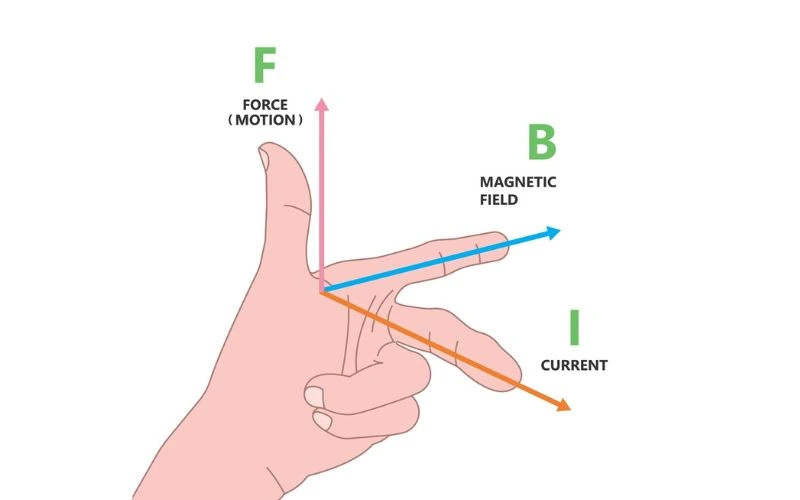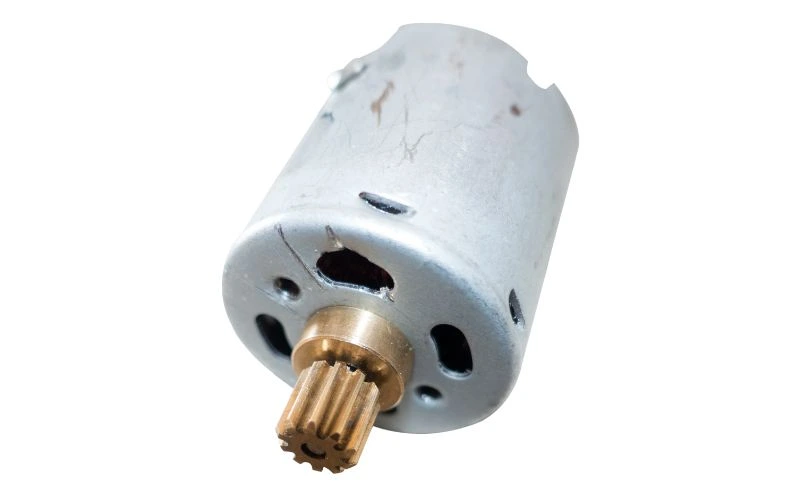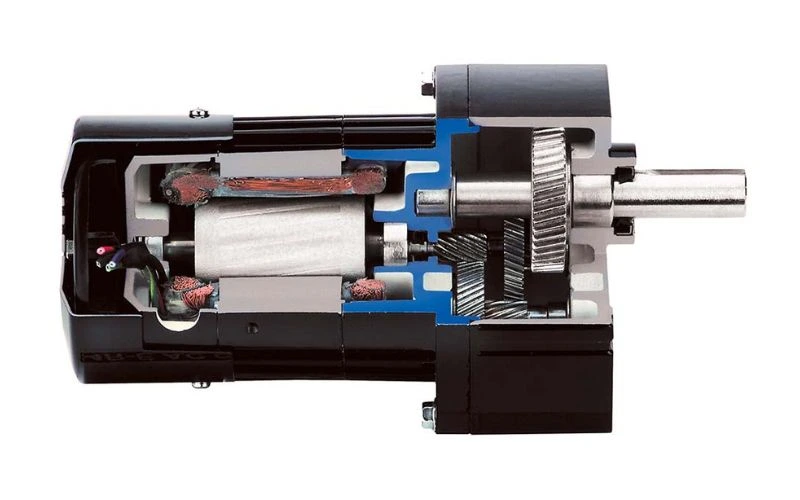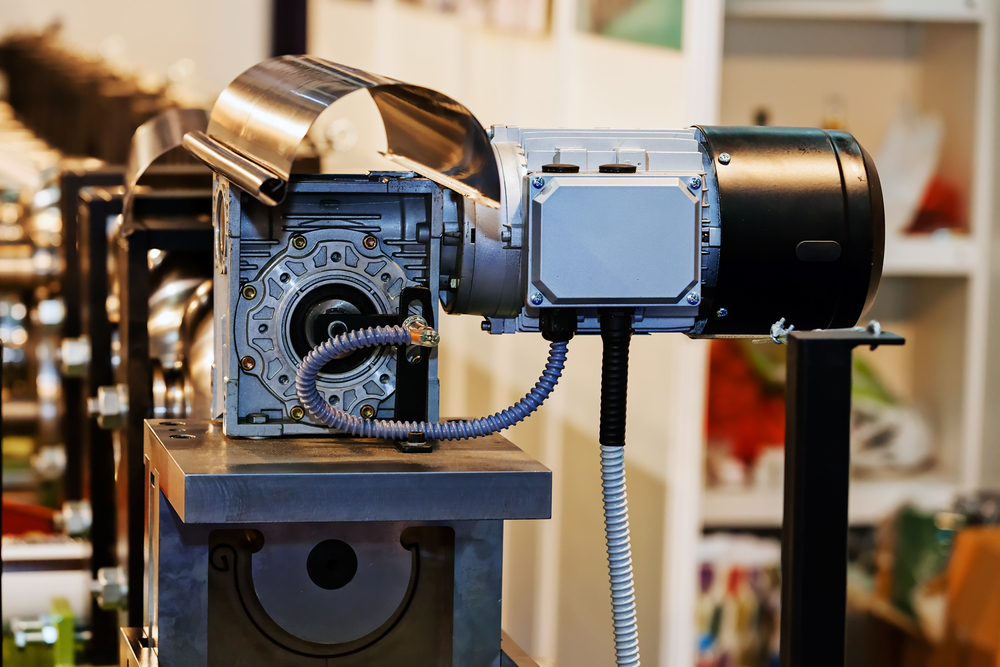
PMDC motors (permanent magnet direct current motors) are compact powerhouses known for their reliability. They take advantage of the ubiquitous strengths of permanent magnets and eliminate the need for a separate field winding, increasing their efficiency. Interestingly, they use the Lorentz force to operate, which creates a mechanical force from the interaction between magnetic fields and electrical currents flowing through the engine's components. Once you understand this principle, you will soon understand why PMDC motors are essential in industries ranging from automotive to home appliances.
PMDC (Permanent Magnet Direct Current) motors are known for their exceptional starting torque, reliability and compact size due to the integration of permanent magnets in the stator. These motors are often used in applications that require high starting torque and precise speed control, making them ideal for the automotive, industrial automation, and robotics industries.
PMDC Motor Overview
Imagine a motor that doesn't require large, clumsy field windings. This motor is called a permanent magnet direct current (PMDC) motor and it does amazing things. It uses powerful permanent magnets in the stator instead of field windings to create a magnetic field. This special design makes PMDC motors compact, economical and capable of providing high starting torque.
Also consider a device that needs to start moving immediately when you press the power button. The strength of this initial movement, also known as high starting torque, is critical in many machines and devices. For example, PMDC motors are often used in automotive applications such as power windows, seats, and mirrors because they need to work immediately when a button is pressed. Household appliances, such as mixers or mixers, start working immediately after being turned on – this is where the high starting torque comes into play.
Additionally, these motors have a wide speed range, allowing them to be used in devices with different speed requirements.
Now you see that PMDC motors are special not only because they do not require field winding, but also because they are compact, reliable and ready to start with high torque – an ideal solution for all types of applications.
Having examined these aspects of PMDC motors, let us now examine how these motors and their power source work by shedding light on their operation and power source.
How a PMDC motor and its power source work
Imagine walking into a room where everything is silent and all that can be heard in your ears is the sound of a machine coming to life. That's the magic of DC motors. They come into action almost instantly when connected to a power source. Let's peel back the layers and understand how these engines work.
Magnetic fields and electric current
The core of a PMDC motor is the interaction between magnetic fields and electrical current. Direct current (DC) flows through the wire wrapped around the rotor, creating an electromagnetic force. Thanks to this force, the rotor starts to rotate. It's like watching a magnet repel or attract another magnet, but in this case it happens over and over again.
Fleming's left hand rule in action

This process relies on Fleming's Left Hand Rule – a fascinating mechanic that wouldn't look out of place in a detective novel. The principle states that if you hold your left hand so that each finger points in a different direction – thumb up, index finger in one direction, and middle finger in another direction – the direction your fingers point is the direction of the magnetic field ( thumb), current (index finger) and strength (middle finger). This is a practical and memorable way to understand how forces behave in magnetic fields.
Power supply
As for the power supply, PMDC motors work directly with DC power supplied through brushes and commutator. The commutator ensures that current flows continuously through the motor windings and maintains uninterrupted rotational movement.
Unidirectional flow for smooth operation
This continuous unidirectional flow is important because it keeps the engine running smoothly and without interruption. It's like having a clear path – no traffic jams! And that's why PMDC motors are ideal for applications that require continuous, reliable motion.
Applications on everyday devices
So when you turn on a device with a PMDC motor – think toys or small appliances – you see a device whose internal configuration allows it to work immediately and with minimal noise.
By understanding how they work, you can understand why they are used in diverse applications where efficiency, reliability and quiet operation are the key factors. Next time you pick up your electric cart or turn on an appliance, know what your movement allows.
In our technological age, PMDC motors silently power many of the devices around us, following these simple guiding principles that keep them running smoothly for years.
Armature and field structure in PMDC motor
The armature is the heart of a PMDC motor. It consists of a cylindrical iron core surrounded by insulated copper coils that are intrinsically wound around it. This assembly forms the moving part of the motor and is crucial in generating electromagnetic forces when electrical current flows through it.
- The number of windings
- The diameter of the wire
- Coil Connections
These factors play an important role in determining the power, speed and torque of the engine.
Field assembly
The field assembly, on the other hand, forms the motor stator and is made up of the permanent magnets. These magnets can be made from ceramic or rare earth, each meeting specific performance requirements.
Interaction between anchor and field
All the magic happens in the interaction between the anchor and field components! When electrical current from the power source flows through the armature, it creates a magnetic field that interacts with the fixed magnetic field created by the stationary magnets in the stator. This mutual interaction creates rotational motion and provides the drive torque essential for engine operation.
- Mutual interaction of magnetic fields
- Creating a rotational movement
- Drive torque for engine operation
Invisible ballet of magnetic fields
Understanding this complex dance of magnetic fields is like experiencing an invisible ballet – each component plays its role perfectly. This symphony of forces within the engine provides the power needed to power numerous applications in our everyday lives.
Tug of war: forces at play
Think of this interaction as a tug of war between two equally strong teams. The armature's electromagnetic field pulls against the fixed field created by the magnets in the stator. When these forces compete with each other in the engine, they create movement – a harmonious balance achieved through careful engineering and meticulous design.
- Tug of war analogy
- Dueling forces in the engine
- Creating movement and balance
Think of it as a graceful dance between partners – each component knows its role in creating an elegant yet powerful performance.
The key to the potential of PMDC motors
Controlling this delicate interaction requires a comprehensive knowledge of electrical and mechanical engineering – the key to unlocking the full potential of a PMDC motor.
Exploring the complex dance of magnetic fields in the structure of PMDC motors shows how this precise design contributes to their impressive performance and versatility in countless applications.
Features of PMDC motors

PMDC motors have special properties that differentiate them from other electric motors. Perhaps the most striking feature of PMDC motors is their high starting torque. Imagine you need a motor that can make something move quickly from a standstill – PMDC motors are perfect for this task. Whether used to drive tools, conveyor belts or industrial automation equipment, PMDC motors accelerate quickly and efficiently, making them essential for applications that require rapid acceleration.
Furthermore, their compact size makes them more attractive. In today's world where space is at a premium, the small size of PMDC motors makes them an ideal choice for applications where size constraints are a concern. From medical devices and robots to automotive systems and home appliances, their ability to deliver robust performance on a small scale is highly valued.
Furthermore, cost efficiency is another notable feature of PMDC motors. Not only are they cheap to buy, they also tend to have lower maintenance costs due to the lack of a brush design. This makes them cost-effective when purchased and requires fewer resources for long-term maintenance.
When it comes to speed control, PMDC motors offer exceptional precision and smoothness. They enable relatively simple variable speed control and provide engineers and designers with a high degree of flexibility in adjusting motor speed to specific application requirements. This makes them suitable for tasks that require precise speed control, such as: B. medical instruments and transport systems where maintaining constant speeds is crucial.
In summary, the characteristics of PMDC motors make them incredibly versatile and adaptable to a wide range of applications. Their high starting torque, compact size, cost-effectiveness and precise speed control capabilities make them an attractive choice for industries ranging from healthcare and manufacturing to automotive and consumer electronics.
Relationship between current, voltage, speed and torque in PMDC motor
To understand the behavior of PMDC motors, it is important to understand the relationship between current, voltage, speed and torque.
Voltage control for speed and torque
- Voltage plays a crucial role in controlling the speed and torque of PMDC motors.
- Motor speed and torque increase as applied voltage increases.
- By adjusting voltage, speed and torque can be adapted to specific applications or operational requirements.
Versatility with customizable features
- Through direct proportionality, PMDC motors are capable of providing adjustable speed and torque characteristics.
- Similar to a car with a continuously variable transmission, increasing the voltage mimics pressing the gas pedal, increasing speed and power.
- PMDC motors are versatile for applications that require precise speed control and variable torque delivery.
Current consumption and mechanical load dynamics
- The current consumption of the motor is mainly determined by the mechanical load to which it is exposed during operation.
- Greater mechanical stress requires more current to maintain rotational motion.
- PMDC motors dynamically respond to environmental changes and adjust power consumption based on real-time needs.
Resistance to load fluctuations
- PMDC motors remain resistant to load fluctuations.
- Consistent performance is guaranteed even under varying operating conditions.
- It is beneficial for engineers and designers to develop systems that require adjustable speed and precise torque control.
Example of use: drill
- An electric drill equipped with a PMDC motor benefits from seamless switching between slow, high-torque operations and faster speeds.
- By modulating the voltage input, versatile performance adapted to different materials is possible.
Insight into versatility and dynamic response
- Understanding the remarkable versatility and dynamic responsiveness of PMDC motors comes from understanding the interplay between current, voltage, speed and torque.
- This knowledge is invaluable in unlocking the full potential of PMDC motors in diverse applications.
With an understanding of the fundamental aspects of PMDC motors, exploration delves into the world of customizing PMDC motors for specific industrial requirements.
Tuning the PMDC motor

Customization is often the key to finding the perfect PMDC motor. Sometimes the standard options are not enough for unique projects or specific applications. By customizing a PMDC motor, you can tailor it to your needs and ensure it meets all your performance, size and functionality requirements.
Wave Drawing
Shaft design is one of the most important aspects when customizing a PMDC motor. The size and shape of the shaft can be adjusted to perfectly fit other components in your system.
Outlet Flanges
Additionally, output flange options are another important consideration when customizing a PMDC motor. Different applications may require different mounting options, and custom output flanges ensure the motor integrates seamlessly into your specific configuration.
Optimize cable length
Cable length is also an important factor to consider when customizing a PMDC motor. It is important to optimize cable length for your application to allow for simple, efficient installation without unnecessary excess cable.
Additional components
Brakes and encoders are additional components that can be integrated into a custom PMDC motor. These additions can provide precise control and safety features needed for specific applications, improving overall engine performance and functionality.
Individual painting
Custom paint finishes can help protect your engine from environmental influences and ensure it fits seamlessly into your equipment or machinery.
Fully customized solutions
In addition to these customizable features, fully customized solutions can also integrate other drive system components to create a coherent, optimized configuration perfectly tailored to your project's unique needs.
For example, you are working on a special robot project that requires a compact yet powerful PMDC motor with special mounting, wiring, and control options. Commercial engines may not provide the exact combination of features needed. By customizing a PMDC motor, you can create a custom solution that perfectly fits your robotic system and ensures optimal performance and efficiency.
Precision and versatility in adjustment
The customization of PMDC motors allows for precision and versatility that commercially available f options cannot match. You can ensure optimal performance of your project by adapting every aspect of the engine to the specific needs of your application – integrating brakes and encoders or selecting the ideal paint finish.
Now that we have a comprehensive understanding of how PMDC motor customization can increase performance to unprecedented levels, let's now explore the diverse applications in which these carefully tailored motors excel.
PMDC Motor Applications
PMDC (permanent magnet direct current) motors are like the Swiss Army knives of the automotive world. They are incredibly versatile and are used across multiple industries and systems. Let's take a look at some of the most common applications and find out why PMDC motors are the first choice for these specific needs.
Automotive systems
PMDC motors power power windows, mirrors, seats, wipers and radiator fans in automotive systems. Their compact design and reliable performance make them ideal for these applications. Additionally, its ability to provide high starting torque is particularly useful in automotive applications where fast, reliable operation is essential for safety and comfort.
Conveyor systems
Conveyor systems in industrial and manufacturing environments rely on PMDC motors for smooth, efficient movement of materials. Precise speed control of PMDC motors ensures smooth movement of products along conveyor belts. Its controllability also allows seamless integration into automation systems, thus optimizing workflows and productivity.
Industrial automation
PMDC motors are crucial in industrial automation, powering various machines and devices. Their ability to maintain constant speeds and provide high torque makes them suitable for precision drilling, milling, cutting and positioning in manufacturing processes. They are also used in assembly line operations where synchronized movements are essential for efficiency.
Packaging equipment
The reliability, controllability and compact size of PMDC motors make them valuable components in packaging systems. They are widely used in packaging machines for filling, sealing, labeling and capping. Its precise speed control ensures precision in these operations, contributing to consistent product quality and packaging efficiency.
Medical equipment
In the medical field, PMDC motors are widely used in various devices such as infusion pumps, medical imaging systems, surgical instruments and laboratory equipment. The controllability and high torque of PMDC motors are essential for the precise movements and adjustments required in medical devices, ensuring accurate diagnoses and treatments.
Eletric tools
Power tools rely on the robust performance of PMDC motors to provide the power and speed needed for a variety of applications such as drilling, grinding, sawing and sanding. The high torque of PMDC motors allows power tools to handle demanding tasks while maintaining consistent performance under load.
It is fascinating to see how PMDC motors can be seamlessly integrated into diverse applications, from automotive systems to medical devices, highlighting their adaptability and reliability across a wide range of industries. Whether providing efficient power for industrial automation or ensuring precision in medical devices, PMDC motors continue to drive innovation and productivity across industries.
Now that we have learned about the numerous uses of PMDC motors in different industries, let's examine how they compare to other electric motors in terms of features and functionality.
PMDC Motor vs. other electric motors: a comparison

When selecting the right engine for a specific application, it is important to understand how different engine types compare. Let's take a closer look at how PMDC motors compare to two commonly used electric motors: induction motors and brushed DC motors.
Induction Motors
Induction motors are commonly used in industrial environments due to their reliability and robust construction. However, they are limited in terms of size and speed control. Unlike PMDC motors, induction motors are limited in variable speed control. They also tend to be larger and less compact, making them less ideal for applications with limited space.
DC motors with brushes
Brushed DC motors, on the other hand, have similarities with PMDC motors, such as: B. their ability to provide high starting torque and their simple construction. However, brushed DC motors require regular maintenance as the brushes and commutators wear out over time, resulting in higher maintenance costs than PMDC motors. Additionally, they are typically larger than PMDC motors, making them less suitable for applications with limited space.
Additionally, PMDC motors offer significant advantages in terms of cost efficiency and variable speed control. Their compact size makes them suitable for applications where space is limited. With their high starting torque and robust construction, PMDC motors offer an efficient solution for precise speed control and reliability scenarios.
In summary, although each type of motor has its advantages and disadvantages, PMDC motors offer a winning combination of compact size, high starting torque, economy, simple construction and variable speed control. This feature is increasingly sought after in modern industrial and consumer applications.
Now that we have a solid understanding of how PMDC motors compare to other types of motors, let's focus on the specific advantages that PMDC motors offer over other competing motor types.
Advantages of PMDC motors over other types of motors
When choosing a motor for various applications, permanent magnet direct current (PMDC) motors offer distinct advantages that set them apart from other types. Let's take a closer look at these unique benefits:
Compact size
A notable advantage of PMDC motors is their compact size. This makes them an ideal choice when space is at a premium, especially for smaller devices where every inch counts. Their small size allows manufacturers to seamlessly integrate these engines into compact systems without sacrificing performance or power. Due to common space limitations, industries such as robotics and medical devices benefit greatly from this feature.
High starting torque
Another important advantage of PMDC motors is their high starting torque. This means they can produce significant torque from start-up, making them suitable for applications that require rapid acceleration or high starting loads. For example, in automotive applications, this high starting torque is critical to efficiently operating various systems such as power windows, windshield wipers and radiator fans.
Easy speed control
PMDC motors offer excellent speed control, allowing operators to smoothly and precisely adjust their speed according to specific requirements. The ability to accurately control engine speed is critical in applications such as conveyor systems, where different line speeds are required for different phases of production. Furthermore, this feature provides flexibility and adaptability in automation processes, thus contributing to improving operational efficiency in various sectors.
Low maintenance effort
PMDC motors have low maintenance requirements compared to other types of motors, making them cost-effective solutions throughout their lifetime. Its simple and robust design minimizes the need for frequent maintenance interventions, thus reducing downtime and operational interruptions. With regular inspection and minimal maintenance, PMDC motors can deliver consistent performance over long periods, making them an attractive choice in industries where reliability is of utmost importance.
Economical and efficient energy conversion
In addition to their compact size and performance, PMDC motors offer efficient power conversion, resulting in long-term economical operation. Its high efficiency contributes to lower energy consumption and reduces operating costs for industrial and automotive applications. Its efficient power conversion improves overall system performance, enabling smoother operations and greater productivity.
Overall, the unique advantages of PMDC motors highlight their versatility and suitability for diverse industrial and automotive applications. They offer compact size, high starting torque, easy speed control, low maintenance and efficient energy conversion – all contributing to improved operational efficiency and savings.
For more information about PMDC motors and their applications, see mytech-info. with . Use the power of PMDC motors for your next project!

